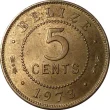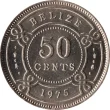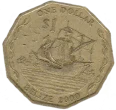Exchange your Belize Dollars
Do you have leftover Belize Dollars? We offer a fast and easy way to exchange both current and withdrawn Belize Dollar banknotes and coins. Don’t let your Belize Dollars sit unused – convert them into local currency today with our quick and convenient exchange service.
$ - BZD
The Belize Dollar (BZD) is the official currency of Belize, a small Caribbean country located on the northeastern coast of Central America. It was introduced in 1885, replacing the earlier British Honduras Dollar, and has been the official currency ever since. The currency is pegged to the U.S. dollar at a fixed exchange rate of 2 BZD to 1 USD, providing stability and confidence for locals and tourists. The Belize Dollar is subdivided into 100 cents, and the country issues both coins and banknotes. Belizean coins come in denominations of 1, 5, 10, 25, and 50 cents, as well as 1 dollar. Banknotes are available in denominations of 2, 5, 10, 20, 50, and 100 dollars. The designs on Belizean banknotes reflect the country’s history, culture, and natural beauty. Notably, the image of Queen Elizabeth II, the former head of state, appears on all Belizean banknotes, a legacy of Belize’s colonial past as part of the British Empire. Belize’s economy is relatively small, with key sectors including tourism, agriculture, and fishing. Tourism is particularly important, as Belize is known for its barrier reef, pristine beaches, and Mayan ruins, attracting visitors from around the world. As a result, the stability of the Belize Dollar is vital for the country’s tourism industry, which relies heavily on international visitors and foreign exchange. The Central Bank of Belize is responsible for issuing the Belize Dollar and managing the country’s monetary policy. Established in 1982, the central bank plays a key role in maintaining the fixed exchange rate with the U.S. dollar, which has helped to keep inflation low and the currency stable. This stability has been crucial for Belize, given its dependence on imports and its vulnerability to external economic shocks. In addition to tourism, agriculture is a major contributor to Belize’s economy, with products such as sugar, citrus fruits, and bananas being essential exports. Fishing and seafood processing are also significant industries, with Belize’s rich marine resources providing a source of income for many Belizeans. The Belize Dollar's stability has helped support these industries by ensuring predictable exchange rates for trade and investment. Belize has also made efforts to diversify its economy, with investments in renewable energy and eco-tourism. These initiatives aim to reduce the country’s reliance on traditional industries and provide greater economic stability in the long term. The Belize Dollar continues to play a vital role in the country’s economic development by providing a stable and reliable currency for domestic and international trade transactions. Despite being a relatively small currency in global terms, the Belize Dollar has maintained its value and stability over the years, largely thanks to the country’s prudent economic policies and its fixed exchange rate with the U.S. dollar. As Belize continues to grow and develop, the Belize Dollar remains an essential part of its financial system. In conclusion, the Belize Dollar has been the official currency of Belize since 1885 and remains stable and reliable. This reflects the country’s economic resilience and close ties to the U.S. dollar.
Belize Dollars Information
The Belize Dollar (BZD) is the official currency of Belize, a small Caribbean country located on the northeastern coast of Central America. It was introduced in 1885, replacing the earlier British Honduras Dollar, and has been the official currency ever since. The currency is pegged to the U.S. dollar at a fixed exchange rate of 2 BZD to 1 USD, providing stability and confidence for locals and tourists.
The Belize Dollar is subdivided into 100 cents, and the country issues both coins and banknotes. Belizean coins come in denominations of 1, 5, 10, 25, and 50 cents, as well as 1 dollar. Banknotes are available in denominations of 2, 5, 10, 20, 50, and 100 dollars. The designs on Belizean banknotes reflect the country’s history, culture, and natural beauty. Notably, the image of Queen Elizabeth II, the former head of state, appears on all Belizean banknotes, a legacy of Belize’s colonial past as part of the British Empire.
Belize’s economy is relatively small, with key sectors including tourism, agriculture, and fishing. Tourism is particularly important, as Belize is known for its barrier reef, pristine beaches, and Mayan ruins, attracting visitors from around the world. As a result, the stability of the Belize Dollar is vital for the country’s tourism industry, which relies heavily on international visitors and foreign exchange.
The Central Bank of Belize is responsible for issuing the Belize Dollar and managing the country’s monetary policy. Established in 1982, the central bank plays a key role in maintaining the fixed exchange rate with the U.S. dollar, which has helped to keep inflation low and the currency stable. This stability has been crucial for Belize, given its dependence on imports and its vulnerability to external economic shocks.
In addition to tourism, agriculture is a major contributor to Belize’s economy, with products such as sugar, citrus fruits, and bananas being essential exports. Fishing and seafood processing are also significant industries, with Belize’s rich marine resources providing a source of income for many Belizeans. The Belize Dollar’s stability has helped support these industries by ensuring predictable exchange rates for trade and investment.
Belize has also made efforts to diversify its economy, with investments in renewable energy and eco-tourism. These initiatives aim to reduce the country’s reliance on traditional industries and provide greater economic stability in the long term. The Belize Dollar continues to play a vital role in the country’s economic development by providing a stable and reliable currency for domestic and international trade transactions.
Despite being a relatively small currency in global terms, the Belize Dollar has maintained its value and stability over the years, largely thanks to the country’s prudent economic policies and its fixed exchange rate with the U.S. dollar. As Belize continues to grow and develop, the Belize Dollar remains an essential part of its financial system.
In conclusion, the Belize Dollar has been the official currency of Belize since 1885 and remains stable and reliable. This reflects the country’s economic resilience and close ties to the U.S. dollar.





